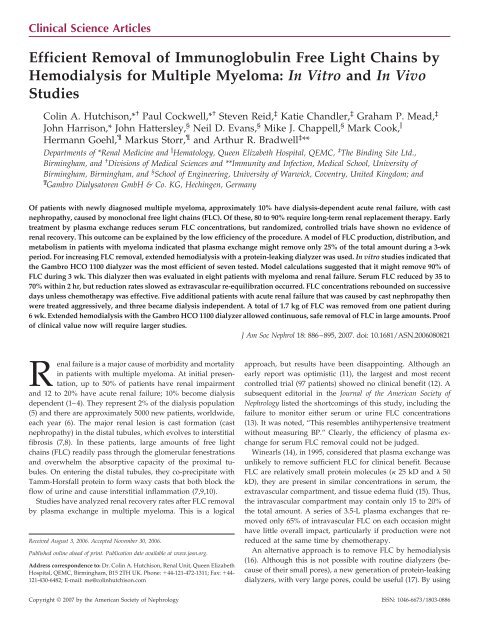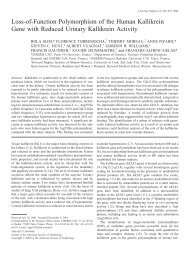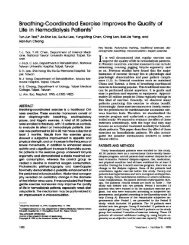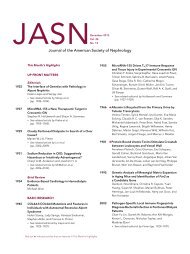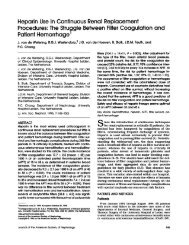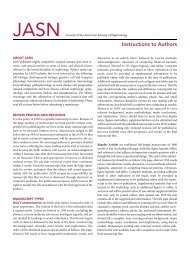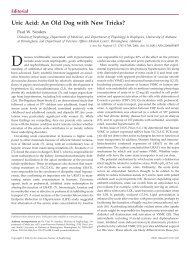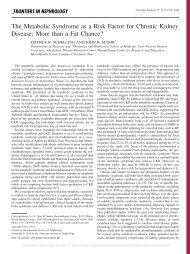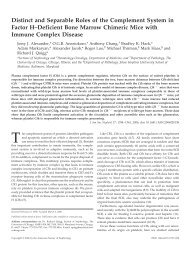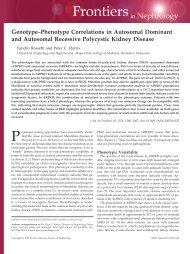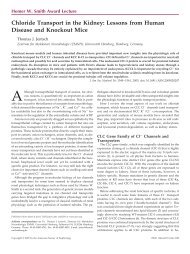Efficient Removal of Immunoglobulin Free Light Chains by ...
Efficient Removal of Immunoglobulin Free Light Chains by ...
Efficient Removal of Immunoglobulin Free Light Chains by ...
You also want an ePaper? Increase the reach of your titles
YUMPU automatically turns print PDFs into web optimized ePapers that Google loves.
Clinical Science Articles<br />
<strong>Efficient</strong> <strong>Removal</strong> <strong>of</strong> <strong>Immunoglobulin</strong> <strong>Free</strong> <strong>Light</strong> <strong>Chains</strong> <strong>by</strong><br />
Hemodialysis for Multiple Myeloma: In Vitro and In Vivo<br />
Studies<br />
Colin A. Hutchison,* † Paul Cockwell,* † Steven Reid, ‡ Katie Chandler, ‡ Graham P. Mead, ‡<br />
John Harrison,* John Hattersley, § Neil D. Evans, § Mike J. Chappell, § Mark Cook, �<br />
Hermann Goehl, ¶ Markus Storr, ¶ and Arthur R. Bradwell ‡ **<br />
Departments <strong>of</strong> *Renal Medicine and � Hematology, Queen Elizabeth Hospital, QEMC, ‡ The Binding Site Ltd.,<br />
Birmingham, and † Divisions <strong>of</strong> Medical Sciences and **Immunity and Infection, Medical School, University <strong>of</strong><br />
Birmingham, Birmingham, and § School <strong>of</strong> Engineering, University <strong>of</strong> Warwick, Coventry, United Kingdom; and<br />
¶ Gambro Dialysatoren GmbH & Co. KG, Hechingen, Germany<br />
Of patients with newly diagnosed multiple myeloma, approximately 10% have dialysis-dependent acute renal failure, with cast<br />
nephropathy, caused <strong>by</strong> monoclonal free light chains (FLC). Of these, 80 to 90% require long-term renal replacement therapy. Early<br />
treatment <strong>by</strong> plasma exchange reduces serum FLC concentrations, but randomized, controlled trials have shown no evidence <strong>of</strong><br />
renal recovery. This outcome can be explained <strong>by</strong> the low efficiency <strong>of</strong> the procedure. A model <strong>of</strong> FLC production, distribution, and<br />
metabolism in patients with myeloma indicated that plasma exchange might remove only 25% <strong>of</strong> the total amount during a 3-wk<br />
period. For increasing FLC removal, extended hemodialysis with a protein-leaking dialyzer was used. In vitro studies indicated that<br />
the Gambro HCO 1100 dialyzer was the most efficient <strong>of</strong> seven tested. Model calculations suggested that it might remove 90% <strong>of</strong><br />
FLC during 3 wk. This dialyzer then was evaluated in eight patients with myeloma and renal failure. Serum FLC reduced <strong>by</strong> 35 to<br />
70% within 2 hr, but reduction rates slowed as extravascular re-equilibration occurred. FLC concentrations rebounded on successive<br />
days unless chemotherapy was effective. Five additional patients with acute renal failure that was caused <strong>by</strong> cast nephropathy then<br />
were treated aggressively, and three became dialysis independent. A total <strong>of</strong> 1.7 kg <strong>of</strong> FLC was removed from one patient during<br />
6 wk. Extended hemodialysis with the Gambro HCO 1100 dialyzer allowed continuous, safe removal <strong>of</strong> FLC in large amounts. Pro<strong>of</strong><br />
<strong>of</strong> clinical value now will require larger studies.<br />
J Am Soc Nephrol 18: 886–895, 2007. doi: 10.1681/ASN.2006080821<br />
Renal failure is a major cause <strong>of</strong> morbidity and mortality<br />
in patients with multiple myeloma. At initial presentation,<br />
up to 50% <strong>of</strong> patients have renal impairment<br />
and 12 to 20% have acute renal failure; 10% become dialysis<br />
dependent (1–4). They represent 2% <strong>of</strong> the dialysis population<br />
(5) and there are approximately 5000 new patients, worldwide,<br />
each year (6). The major renal lesion is cast formation (cast<br />
nephropathy) in the distal tubules, which evolves to interstitial<br />
fibrosis (7,8). In these patients, large amounts <strong>of</strong> free light<br />
chains (FLC) readily pass through the glomerular fenestrations<br />
and overwhelm the absorptive capacity <strong>of</strong> the proximal tubules.<br />
On entering the distal tubules, they co-precipitate with<br />
Tamm-Horsfall protein to form waxy casts that both block the<br />
flow <strong>of</strong> urine and cause interstitial inflammation (7,9,10).<br />
Studies have analyzed renal recovery rates after FLC removal<br />
<strong>by</strong> plasma exchange in multiple myeloma. This is a logical<br />
Received August 3, 2006. Accepted November 30, 2006.<br />
Published online ahead <strong>of</strong> print. Publication date available at www.jasn.org.<br />
Address correspondence to: Dr. Colin A. Hutchison, Renal Unit, Queen Elizabeth<br />
Hospital, QEMC, Birmingham, B15 2TH UK. Phone: �44-121-472-1311; Fax: �44-<br />
121-430-6482; E-mail: me@colinhutchison.com<br />
approach, but results have been disappointing. Although an<br />
early report was optimistic (11), the largest and most recent<br />
controlled trial (97 patients) showed no clinical benefit (12). A<br />
subsequent editorial in the Journal <strong>of</strong> the American Society <strong>of</strong><br />
Nephrology listed the shortcomings <strong>of</strong> this study, including the<br />
failure to monitor either serum or urine FLC concentrations<br />
(13). It was noted, “This resembles antihypertensive treatment<br />
without measuring BP.” Clearly, the efficiency <strong>of</strong> plasma exchange<br />
for serum FLC removal could not be judged.<br />
Winearls (14), in 1995, considered that plasma exchange was<br />
unlikely to remove sufficient FLC for clinical benefit. Because<br />
FLC are relatively small protein molecules (� 25 kD and � 50<br />
kD), they are present in similar concentrations in serum, the<br />
extravascular compartment, and tissue edema fluid (15). Thus,<br />
the intravascular compartment may contain only 15 to 20% <strong>of</strong><br />
the total amount. A series <strong>of</strong> 3.5-L plasma exchanges that removed<br />
only 65% <strong>of</strong> intravascular FLC on each occasion might<br />
have little overall impact, particularly if production were not<br />
reduced at the same time <strong>by</strong> chemotherapy.<br />
An alternative approach is to remove FLC <strong>by</strong> hemodialysis<br />
(16). Although this is not possible with routine dialyzers (because<br />
<strong>of</strong> their small pores), a new generation <strong>of</strong> protein-leaking<br />
dialyzers, with very large pores, could be useful (17). By using<br />
Copyright © 2007 <strong>by</strong> the American Society <strong>of</strong> Nephrology ISSN: 1046-6673/1803-0886
J Am Soc Nephrol 18: 886–895, 2007 <strong>Removal</strong> <strong>of</strong> Ig FLC <strong>by</strong> Hemodialysis for Multiple Myeloma 887<br />
extended dialysis, large amounts <strong>of</strong> FLC might be removed<br />
without the attendant clotting and deproteination problems<br />
that limit the extended use <strong>of</strong> plasma exchange. The aims <strong>of</strong> this<br />
study were to (1) make in vitro and in vivo assessments <strong>of</strong><br />
several protein-leaking hemodialyzers, (2) develop a theoretical<br />
model for FLC removal, and (3) identify a clinical strategy for<br />
reduction <strong>of</strong> FLC in patients with multiple myeloma, with a<br />
view towards facilitating renal recovery.<br />
Materials and Methods<br />
This study was approved <strong>by</strong> the Solihull and South Birmingham<br />
Research Ethics Committees and the Research and Development Department<br />
<strong>of</strong> the University Hospitals Birmingham NHS Foundation<br />
Trust. All patients gave informed, oral and written consent.<br />
Study Design and Participants<br />
The study comprised (1) an initial in vitro and in vivo assessment <strong>of</strong><br />
dialyzers for clearance <strong>of</strong> FLC, (2) development <strong>of</strong> a compartmental<br />
model for FLC removal on the basis <strong>of</strong> observed dialysis results, and (3)<br />
use <strong>of</strong> the model and the most efficient dialyzer to determine the<br />
optimal strategy for removal <strong>of</strong> FLC from patients with renal failure<br />
complicating multiple myeloma. The patients investigated were attending<br />
or referred to the nephrology department at the Queen Elizabeth<br />
Hospital.<br />
In Vitro Assessment <strong>of</strong> FLC <strong>Removal</strong> <strong>by</strong> Isolated<br />
Ultrafiltration<br />
Seven dialyzers were assessed for filtration efficiency (Table 1). Human<br />
serum, obtained from the Blood Transfusion Service, was spiked<br />
with 1000 mg <strong>of</strong> both monoclonal � and � FLC. Each dialyzer was<br />
placed in a simple circuit and primed with 1L<strong>of</strong>normal saline. One liter<br />
<strong>of</strong> serum then was recirculated through the dialyzers at 400 ml/min, with<br />
transmembrane pressures <strong>of</strong> between 300 and 400 mmHg. The procedure<br />
was stopped when production <strong>of</strong> ultrafiltrate (UF) fluid ceased. The dialyzers<br />
finally were flushed with 1L<strong>of</strong>fresh saline to remove fluid that<br />
contained any residual protein. The quantities <strong>of</strong> FLC in the filtered serum,<br />
UF, and flushed fluid were calculated from the FLC concentrations and<br />
measured volumes. Serum FLC reductions were calculated <strong>by</strong> subtraction<br />
<strong>of</strong> the final FLC concentrations from the initial values. The percentage <strong>of</strong><br />
the original 1000 mg <strong>of</strong> each FLC, present in the UF at the end <strong>of</strong> the<br />
Table 1. Efficiency <strong>of</strong> dialyzers for in vitro removal <strong>of</strong> FLC <strong>by</strong> isolated ultrafiltration a<br />
Class Make Model<br />
Membrane<br />
Material<br />
Surface<br />
Area<br />
(m 2 )<br />
experiment, was calculated to determine the ability <strong>of</strong> the membrane to<br />
filter FLC. These assessments were repeated three times for each dialyzer,<br />
and the mean values were determined.<br />
In Vitro Assessment <strong>of</strong> FLC <strong>Removal</strong> <strong>by</strong> Hemodialysis<br />
The two dialyzers that filtered most FLC, the Toray BK-F 2.1 (Toray<br />
Industries Inc, Tokyo, Japan) and the Gambro HCO (high cut<strong>of</strong>f) 1100<br />
(Gambro Dialysatoren GmbH, Hechingen, Germany), were assessed in<br />
vitro for dialysis efficiency. Each dialyzer was connected to a Gambro<br />
AK 90 hemodialysis machine and primed with 1L<strong>of</strong>normal saline.<br />
One liter <strong>of</strong> human serum that contained 1000 mg <strong>of</strong> both � and � FLC<br />
then was dialyzed for 4 h. Serum flow rates were set at 300 ml/min,<br />
dialysate flow rates were set at 500 ml/min, and transmembrane pressures<br />
were set at 0 to 10 mmHg. Ultrafiltration rates <strong>of</strong> 0.05 and 0.25<br />
L/h were used arbitrarily for the Gambro HCO 1100 and the Toray<br />
BK-F, respectively. Serum volumes were maintained at 1 L <strong>by</strong> an<br />
infusion <strong>of</strong> normal saline. After 2 h, the serum was spiked with 24 ml<br />
<strong>of</strong> saline that contained an additional 1000 mg <strong>of</strong> both � and � FLC to<br />
assess dialyzer blockage. Serum and dialysate fluids were sampled at<br />
short intervals for the FLC measurements (12 to 17 samples for each<br />
experimental part). Clearance values for � and � were calculated as<br />
follows (18):<br />
dialysate concentration <strong>of</strong> FLC<br />
Clearance (ml/min) � � dialysate flow rate<br />
inlet serum concentration <strong>of</strong> FLC<br />
Mean dialysate concentrations <strong>of</strong> FLC and clearance rates were calculated<br />
from both pre- and postspike samples, for both dialyzers and<br />
differences assessed.<br />
In Vivo Assessment <strong>of</strong> FLC <strong>Removal</strong> in Patients with<br />
Multiple Myeloma<br />
During the study period, 13 patients with dialysis-dependent renal<br />
failure (estimated GFR �15 ml/min per 1.73 m 2 ) and multiple myeloma<br />
presented to the Nephrology Department. The first three patients underwent<br />
dialysis on one or more <strong>of</strong> the following dialyzers to determine<br />
their individual efficiency for FLC clearance: B. Braun Hi-PeS 18, (B.<br />
Braun Medical Ltd, Sheffield, UK) Toray BK-F 2.1, and Gambro HCO<br />
1100. Subsequent patients underwent dialysis only on the Gambro<br />
HCO 1100 because <strong>of</strong> its superior FLC clearance rates (Tables 2 and 3).<br />
Patients 4 and 5 had routine dialysis for 4 h thrice weekly. Extended<br />
Molecular<br />
Cut<strong>of</strong>f in Blood<br />
(kD)<br />
Mean Reduction<br />
in FLC (%)<br />
Mean FLC<br />
Concentration<br />
in UF (%)<br />
� � � �<br />
High flux B. Braun Hi-PeS 18 PES 1.8 10 54 39 17 12<br />
Asahi APS-1050 PS 2.1 10 b<br />
71 65 30 18<br />
Nikkiso FLX 8GWS PEPA 1.8 10 b<br />
68 45 12 11<br />
Idemsa 200 MHP PES 2.0 10 b<br />
67 59 21 16<br />
Super flux Toray BK-F 2.1 PMMA 2.1 20 c<br />
88 73 0.1 0.2<br />
Toray BG 2.1 PMMA 2.1 20 c<br />
71 41 0.1 0.1<br />
High cut<strong>of</strong>f Gambro HCO 1100 PAES 1.1 45 c<br />
96 94 62.5 90<br />
a<br />
FLC, free light chains; PAES, polyarylethersulfone; PEPA, polyester polymer alloy; PES, polyethersulfone; PMMA,<br />
polymethyl methacrylate; PS, polysulfone; UF, ultrafiltrate.<br />
b<br />
This is an approximate size because manufacturers’ data were not available.<br />
c<br />
Obtained from manufacturer.
888 Journal <strong>of</strong> the American Society <strong>of</strong> Nephrology J Am Soc Nephrol 18: 886–895, 2007<br />
Table 2. Clinical details <strong>of</strong> patients who had MM and were treated <strong>by</strong> hemodialysis a<br />
Patient Age<br />
Myeloma<br />
Type<br />
Presentation<br />
FLC<br />
Concentration<br />
(mg/L)<br />
Chemotherapy<br />
Regimen<br />
hemodialysis with the Gambro HCO dialyzer was evaluated in patients<br />
6 through 8. Daily extended hemodialysis on the Gambro HCO dialyzer<br />
was evaluated for FLC removal in patients 9 through 13, who<br />
presented with cast nephropathy.<br />
Serum and dialysate concentrations <strong>of</strong> FLC were measured at short<br />
intervals during the dialysis sessions. Percentage serum reductions in<br />
FLC, mean dialysate concentrations (mg/L), dialysate FLC content per<br />
hour <strong>of</strong> dialysis (g/h), and clearance rates (ml/min) were calculated.<br />
These results were compared for each membrane for the first three<br />
patients.<br />
Evaluation <strong>of</strong> FLC <strong>Removal</strong> <strong>by</strong> Extended Hemodialysis on<br />
the Gambro HCO 1100<br />
An extended dialysis regimen <strong>of</strong> up to 12 h was evaluated in eight<br />
patients (6–13) with dialysate flow rates <strong>of</strong> between 300 and 500 ml/min<br />
and blood flow rates <strong>of</strong> 150 to 250 ml/min. Some patients were treated<br />
with two or three dialyzers in series (Table 3). The following correlations<br />
were assessed: Serum FLC concentrations with quantity <strong>of</strong> FLC in<br />
the dialysate, serum reductions with duration <strong>of</strong> dialysis, clearance<br />
rates with dialysate flow rates, and dialyzer surface area. Cardiovascular<br />
stability was monitored throughout each dialysis session. Serum<br />
FLC, albumin, and electrolyte concentrations were measured before<br />
and after dialysis.<br />
Therapeutic Extended Daily Hemodialysis on the Gambro<br />
HCO 1100 for Patients with Cast Nephropathy<br />
During the study period, five patients (9 through 13) presented<br />
with new multiple myeloma, acute renal failure, and biopsy-proven<br />
Renal<br />
Diagnosis<br />
Adverse<br />
Events<br />
Supportive<br />
Therapy<br />
Clinical<br />
Outcomes<br />
Evaluation <strong>of</strong> FLC removal <strong>by</strong> hemodialysis<br />
1 61 New IgG� 17,000 CThal Dex ARF, no biopsy C. diff. Nil Renal recovery<br />
2 73 Relapsing IgG� 1780 CThal Dex CKD, no biopsy Bone fractures Nil ESRF<br />
3 42 New FLC � 6980 CThal Dex ARF, cast nephropathy AL amyloidosis Albumin ESRF<br />
4 77 New IgG� 5140 Cyc and Dex ARF, no biopsy Septicemia Albumin Died <strong>of</strong> MRSA<br />
septicemia<br />
5 59 New IgG� 734 Thal Dex CKD, no biopsy Nil Albumin Dialysis dependent<br />
6 78 New FLC � 15,900 CThal Dex CKD, severe interstitial<br />
fibrosis<br />
Nil Albumin ESRF<br />
7 70 Relapsing FLC � 7950 Idarubicin, Dex,<br />
Cyc<br />
ARF, no biopsy C. diff. and<br />
septicemia<br />
Albumin, NHIg Died from<br />
neutropenic<br />
sepsis<br />
8 63 New IgG� 656 Dex ARF, ATN Nil Nil Renal recovery<br />
Extended daily hemodialysis for cast nephropathy<br />
9 68 MGUS 3 IgG� 1030 Thal Dex ARF, cast nephropathy Nil Albumin Renal recovery<br />
eGFR at 9 mo � 49<br />
10 51 New IgA� 42,000 VAD ARF, cast nephropathy Nil Albumin, NHIg,<br />
prophylactic<br />
antibiotics,<br />
GCSF<br />
Dialysis<br />
dependent<br />
11 61 New IgA� 13,500 Thal Dex ARF, cast nephropathy Nil Albumin, NHIg Renal recovery<br />
eGFR at 4 mo � 29<br />
12 68 New IgG� 1120 Thal Dex ARF, cast nephropathy C. diff., lobar<br />
pneumonia<br />
and ACS<br />
Albumin, NHIg Ongoing treatment<br />
13 81 New IgG� 110 Dex, Cyc ARF, cast nephropathy Nil Albumin, NHIg Renal recovery<br />
eGFR at 3 mo � 36<br />
a ACS, acute coronary syndrome; ARF, acute renal failure; ATN, acute tubular necrosis; C. diff., Clostridium difficile;<br />
CKD, chronic kidney disease; CThalDex, cyclophosphamide, thalidomide, and dexamethasone; Thal Dex, thalidomide<br />
and dexamethasone; Cyc, cyclophosphamide; Dex, dexamethasone; ESRF, end-stage renal failure (eGFR �10 ml/min per<br />
1.73 m 2 ); eGFR, estimated GFR (<strong>by</strong> Cockr<strong>of</strong>t-Gault equation in ml/min per 1.73 m 2 ); GCSF, granulocyte colonystimulating<br />
factor; MM, multiple myeloma; MGUS, monoclonal gammopathy <strong>of</strong> undetermined significance evolved to<br />
MM; MRSA, methicillin-resistant Staphylococcus aureus; NHIg, normal human Ig; VAD, vincristine, Adriamycin<br />
(doxorubicin), dexamethasone.<br />
cast nephropathy. An extended, daily dialysis regimen was undertaken<br />
in an attempt to reduce rapidly serum FLC concentrations. All<br />
patients received induction chemotherapy using local hematology<br />
protocols (Table 2). FLC clearance rates were evaluated with dialysate<br />
flow rates <strong>of</strong> between 300 and 500 ml/min and blood flow rates<br />
<strong>of</strong> 150 to 250 ml/min. Patients were assessed daily for determination<br />
<strong>of</strong> fluid balance with the aim <strong>of</strong> maintaining euvolemia. Ultrafiltration<br />
was used in addition to hemodialysis when there was fluid<br />
overload, and intravenous infusions were used to correct dehydration.<br />
Serum Ig were measured for assessment <strong>of</strong> immune status and<br />
normal human Ig were given, at 0.5 g/kg body wt, when serum IgG<br />
concentrations were �5 g/L.<br />
Laboratory Measurements <strong>of</strong> FLC<br />
Serum and dialysate � and � FLC concentrations were measured <strong>by</strong><br />
nephelometry, on a Dade-Behring BNII Analyser, using a particleenhanced,<br />
high-specificity, homogeneous immunoassay (FREELITE;<br />
The Binding Site, Birmingham, UK) (19). Normal serum reference<br />
ranges used were 7.3 mg/L (range 3.3 to 19.4) for � and 12.7 mg/L<br />
(range 5.7 to 26.3) for � with an assay sensitivity <strong>of</strong> �1 mg/L (20).<br />
Mathematical Model <strong>of</strong> FLC <strong>Removal</strong> in Patients with<br />
Multiple Myeloma<br />
A two-compartment mathematical model <strong>of</strong> FLC production, distribution,<br />
and removal in multiple myeloma was constructed to compare<br />
the efficiencies <strong>of</strong> plasma exchange and hemodialysis (Figure 1) (21).<br />
This was similar in structure to models for dialysis removal <strong>of</strong> urea and<br />
�2-microglobulin (22,23). It consisted <strong>of</strong> intravascular and extravascu-
J Am Soc Nephrol 18: 886–895, 2007 <strong>Removal</strong> <strong>of</strong> Ig FLC <strong>by</strong> Hemodialysis for Multiple Myeloma 889<br />
Table 3. Summary <strong>of</strong> FLC removal <strong>by</strong> hemodialysis in patients with MM a<br />
Patient FLC Dialyzer Make<br />
No. <strong>of</strong><br />
Dialysis<br />
Sessions<br />
(Dialysers) d<br />
Mean (Range)<br />
Length <strong>of</strong><br />
Dialysis<br />
Sessions<br />
(h)<br />
Mean<br />
Predialysis<br />
Serum<br />
Concentration<br />
(mg/L)<br />
lar compartments (one and two, respectively) with flow <strong>of</strong> FLC into,<br />
between, and out <strong>of</strong> each compartment (15). The renal clearance <strong>of</strong><br />
serum FLC was considered zero (estimated GFR � 0) in patients with<br />
renal failure. Under such conditions, removal was <strong>by</strong> the reticuloendothelial<br />
system only, with a half-life <strong>of</strong> 3 d (24). With the use <strong>of</strong> this<br />
half-life, a production rate <strong>of</strong> 33.8 g/d produced a steady state <strong>of</strong><br />
10 g/L in the intravascular compartment. This was a convenient starting<br />
value for the clearance simulations.<br />
Data from a patient with multiple myeloma were analyzed using the<br />
model within the s<strong>of</strong>tware package Facsimile (25) to generate rates <strong>of</strong><br />
Mean % Reduction<br />
in Serum<br />
Concentrations<br />
Mean (Range)<br />
Dialysate<br />
Concentration<br />
(mg/L)<br />
Mean<br />
Dialysate<br />
Content<br />
(mg/h)<br />
Mean<br />
Clearances<br />
Rates<br />
(ml/min)<br />
Sustained %<br />
Serum<br />
Reduction<br />
Achieved<br />
Evaluation <strong>of</strong> FLC removal <strong>by</strong> hemodialysis NA<br />
1 � Toray BK-F 2.1 7 3.6 (2 to 4) 11,580 3.2 6.9 (0.8 to 20.3) 200 0.29<br />
2 � B. Braun Hi-Pes 18 2 3.75 (3.5 to 4) 1795 5.6 b<br />
5.3 b (2.7 to 9.5) 160 b<br />
1.5 b<br />
Toray BK-F 2.1 3 4 2950 24.2 b<br />
2 b (0.5 to 3.5) 60 b<br />
0.5 b<br />
Gambro HCO 1100 2 4 9155 58.5 265.6 (88 to 648) 7800 22<br />
3 � Toray BK-F 2.1 4 3.6 (3 to 4) 8002 22.5 b<br />
11.1 b (6.4 to 30.4) 720 b<br />
1.6 b<br />
Gambro HCO 1100 6 4 2880 44.5 163 (120 to 219) 4900 30.4<br />
4 � Gambro HCO 1100 6 2.9 (2 to 4) 3361 23.6 101 (36 to 241) 3200 15.6<br />
5 � Gambro HCO 1100 3 3.3 (2 to 4) 536 57.9 7.1 (4.2 to 9.9) 200 14.8<br />
6 � Gambro HCO 1100 10 4.6 (4 to 6) 10,548 58.9 219 (65 to 843) 6600 16.2<br />
7 � Gambro HCO 1100 11 6.9 (2 to 11) 4651 57.8 137 (28.6 to 411) 2600 16.8<br />
8 � Gambro HCO 1100 3 10.7 (10 to 12) 494 53.8 18 (8 to 37.3) 300 15.9<br />
Extended daily hemodialysis for cast nephropathy<br />
9 � Gambro HCO 1100 13 4.8 (2 to 8) 445 45 18.1 (1.6 to 56) 370 17.1 95 c<br />
10 � Gambro HCO 1100 (1) 12 7.25 (1 to 10) 22,408 36 439 (15 to 1610) 9700 9.2 50<br />
(2) 6 6.5 (6 to 8) 17,610 57 514 (187 to 1370) 15,700 25.6<br />
(3) 1 8 18,800 75 515 (151 to 1810) 11,600 31.5<br />
11 � Gambro HCO 1100 (1) 2 9 (6 to 12) 12,850 35.1 307 (200 to 414) 5600 11.6 85 c<br />
(2) 20 6.3 (3 to 10) 6887 81 193 (53 to 409) 5700 25.5<br />
12 � Gambro HCO 1100 (1) 2 9 (6 to 12) 1004 66.4 34 (21 to 47) 600 28.5 0<br />
(2) 46 6.3 (4 to 10) 1157 80.4 46 (21 to 91) 1300 42.9<br />
13 � Gambro HCO 1100 (1) 2 5 (4 to 6) 1357 58 28.9 (9 to 48) 800 13.5 80 c<br />
(2) 12 6.3 (6 to 10) 397 74 13.7 (6 to 26) 250 33<br />
a NA, not applicable.<br />
b Significantly less than the Gambro HCO 1100 result for this patient (P � 0.02).<br />
c Percentage <strong>of</strong> FLC reduction achieved when patients became dialysis independent.<br />
d Number <strong>of</strong> dialysers in series.<br />
Figure 1. <strong>Free</strong> light chain (FLC) compartmental model. Parameters<br />
were as follows: P(t), FLC production rate (23 mg/min); k 1e, elimination<br />
rate as a result <strong>of</strong> renal function (0 mg/min); k d, elimination<br />
rate as a result <strong>of</strong> dialysis (1.5 � 10 �2 /min); k 12, rate constant<br />
<strong>of</strong> FLC flow between intra- and extravascular compartments<br />
(2.15 � 10 �2 /min); k 21, rate constant <strong>of</strong> FLC flow between extraand<br />
intravascular compartments (4.3 � 10 �3 /min); k re, elimination<br />
rate as a result <strong>of</strong> the reticuloendothelial metabolism (1.6 �<br />
10 �4 /min). Intravascular compartment volume 2.5 L; extravascular<br />
compartment volume 12 L.<br />
serum FLC removal. Simulations then were conducted to compare six<br />
and 10 plasma exchange treatments (over 12 d) with five different<br />
hemodialysis protocols. Chemotherapeutic tumor killing rates <strong>of</strong> 0, 2, 5,<br />
and 10% per day and 100% on the first day were used (Table 4).<br />
Statistical Analyses<br />
In vitro and in vivo studies <strong>of</strong> FLC removal <strong>by</strong> hemodialysis were<br />
compared using t test (two tailed, type 2) for significant differences. P �<br />
0.05 was considered statistically significant.<br />
Results<br />
In Vitro Assessment <strong>of</strong> FLC <strong>Removal</strong> <strong>by</strong> Isolated<br />
Ultrafiltration<br />
The efficiencies <strong>of</strong> the various dialyzers for removal <strong>of</strong> FLC<br />
are shown in Table 1. All dialyzers caused substantial reductions<br />
<strong>of</strong> FLC concentrations in the circulated serum. Varying<br />
amounts <strong>of</strong> FLC were identified in UF, and it was assumed that<br />
the amounts missing were bound to the membranes. The Gambro<br />
HCO 1100 was the most efficient dialyzer; only small<br />
amounts <strong>of</strong> FLC bound to the membranes.<br />
In Vitro Assessment <strong>of</strong> FLC <strong>Removal</strong> <strong>by</strong> Hemodialysis<br />
The results for FLC removal <strong>by</strong> in vitro hemodialysis using<br />
the Toray BK-F 2.1 and the Gambro HCO 1100 dialyzers are<br />
shown in Table 5. Significantly higher FLC dialysate concentrations<br />
and greater serum reductions were achieved using the<br />
Gambro HCO dialyzer. Clearance rates <strong>of</strong> both FLC were 60-
890 Journal <strong>of</strong> the American Society <strong>of</strong> Nephrology J Am Soc Nephrol 18: 886–895, 2007<br />
Table 4. Model calculations <strong>of</strong> the efficiency <strong>of</strong> therapeutic removal <strong>of</strong> FLC a<br />
Method <strong>of</strong> FLC <strong>Removal</strong><br />
fold higher using the Gambro dialyzer compared with the<br />
Toray dialyzer.<br />
In Vivo Use <strong>of</strong> Dialyzers for FLC <strong>Removal</strong> in Patients with<br />
Multiple Myeloma<br />
The clinical details <strong>of</strong> patients who were studied for FLC<br />
removal are summarized in Table 2. All were in dialysisdependent<br />
renal failure. FLC removal <strong>by</strong> hemodialysis was<br />
evaluated for three different dialyzers in the first three patients.<br />
Details <strong>of</strong> the dialysis periods and the amounts <strong>of</strong> FLC<br />
removed are shown in Table 3. For example, in patient 2, use<br />
<strong>of</strong> the Gambro HCO 1100 resulted in greater reductions in<br />
serum FLC concentrations (58.5%) than either the B. Braun<br />
Hi-Pes 18 (5.6%; P � 0.002) or the Toray BK-F 2.1 (24.2%; P �<br />
0.001). The mean dialysate concentrations <strong>of</strong> FLC were many<br />
times higher during the dialysis sessions using the Gambro<br />
HCO 1100 (266 versus 5 mg/L using the B. Braun Hi-Pes 18<br />
[P � 0.02] and 2 mg/L using the Toray BK-F 2.1 [P � 0.004]).<br />
Later patients (4 through 13) were treated only with the<br />
Gambro HCO 1100 dialyzer.<br />
Evaluation <strong>of</strong> FLC <strong>Removal</strong> <strong>by</strong> Extended Hemodialysis on<br />
the Gambro HCO 1100<br />
Extended hemodialysis (�4 h) on the Gambro HCO 1100 was<br />
evaluated for FLC removal in patients 6 through 13 (Table 3).<br />
Table 5. Efficiency <strong>of</strong> dialyzers for in vitro removal <strong>of</strong> FLC during 4h<strong>of</strong>hemodialysis a<br />
Membrane Test samples<br />
The procedure was well tolerated with no cardiovascular complications.<br />
During sessions, there was a mean serum albumin<br />
reduction <strong>of</strong> 3.9 g/L (P � 0.03) that was replaced routinely with<br />
20% albumin solution. Calcium and magnesium were replaced<br />
as required. Measurements indicated that there was no IgG<br />
leakage into the dialysate fluid.<br />
The amounts <strong>of</strong> FLC in the dialysate fluids correlated with<br />
predialysis serum concentrations (R � 0.74, P � 0.0001). Figure<br />
2 shows serum and dialysate FLC concentrations during a 6-h<br />
session for patient 6. When the dialyzer was replaced, there was<br />
a transient increase in FLC removal. Figures 3 through 5 show<br />
the daily pre- and postdialysis serum FLC concentrations and<br />
the amounts <strong>of</strong> FLC removed in the dialysate fluid (per 10-d<br />
periods) for patients 9 through 11, together with details <strong>of</strong><br />
chemotherapy.<br />
There was a significant correlation between percentage serum<br />
FLC reduction and the time on hemodialysis for all patients<br />
(R � 0.53, P � 0.001). Under similar conditions, mean<br />
clearance rates <strong>of</strong> FLC varied little between patients and correlated<br />
with dialysate flow rates (R � 0.58, P � 0.0001). The<br />
clearance was 10.8 ml/min at flow rates <strong>of</strong> 300 ml/min (range<br />
5.2 to 22.6) and 19.3 ml/min (range 7.2 to 39.8) at 500 ml/min.<br />
Dialyzer surface area also was related to FLC clearance rates.<br />
For example, patient 10 was dialyzed on separate occasions on<br />
Prespike Postspike Mean Values Clearance Rates (ml/min)<br />
� � � � � � � �<br />
Toray BK-F 2.1 Serum % removed 77.9 75 88.8 84.3 81.5 78 0.59 (0.02 to 1.6) 0.47 (0.02 to 1.4)<br />
Dialysate concentration b<br />
0.63 0.87 2 2.2 1.3 1.54<br />
Gambro HCO 1100 Serum % removed 95 93 96 95 95.5 c<br />
94 c<br />
35.1 c (7.5 to 50.9) 32.2 c (19.1 to 45.9)<br />
Dialysate concentration b<br />
50 88 75 93 62.5 c<br />
90 c<br />
a Mean results were determined for pre- and postspike data.<br />
b FLC concentrations in dialysate fluid in mg/L.<br />
c Gambro dialyzer significantly more efficient (P � 0.02).<br />
Percentage <strong>of</strong> FLC Removed <strong>by</strong> Intervention<br />
(and Time �D�, to Reduce from 10 to 0.5 g/L)<br />
with Different Chemotherapeutic Tumor Killing Rates c<br />
100% 10% 5% 2% 0%<br />
None NA (14) 1<br />
NA (30) 2<br />
NA (52) NA (121) NA (10 g/L) b8<br />
PE �6 in 10 d 29 (10) 24 (29) 3<br />
17 (52) 9 (121) 3 (10 g/L) b<br />
PE �10 in 10 d 40 (8) 34 (29) 25 (52) 13 (121) 4 (10 g/L) b<br />
HD4h�3/wk 60 (7) 54 (19) 4<br />
53 (31) 51 (73) 50 (3.6 g/L) b<br />
HD 4 h/d 76 (4) 73 (13) 5<br />
72 (23) 71 (55) 70 (1.9 g/L) b<br />
HD 8 h alternate days 79 (4) 73 (13) 72 (19) 70 (47) 69 (1.5 g/L) b7<br />
HD 8 h/d 87 (3) 85 (7) 84 (14) 83 (29) 82 (1.0 g/L) b<br />
HD 12 h/d 91 (2) 89 (5) 6<br />
89 (8) 88 (16) 88 (0.7 g/L) b<br />
HD 18 h/d 93 (2) 93 (3) 93 (4) 92 (8) 91 (0.6 g/L) b<br />
a Numbers are the additional percentage <strong>of</strong> FLC removed <strong>by</strong> intervention compared with normal metabolism. Numbers in<br />
parentheses are the time in days for FLC concentrations to reduce <strong>by</strong> 95% (from 10 to 0.5 g/L). For superscript numbers 1<br />
through 8, the simulations are shown in Figure 7. HD, hemodialysis; PE, plasma exchange.<br />
b Serum FLC concentrations at day 150 for simulations in which reductions to 0.5 g/L did not occur.<br />
c Percentage tumor kill rates per day.
J Am Soc Nephrol 18: 886–895, 2007 <strong>Removal</strong> <strong>of</strong> Ig FLC <strong>by</strong> Hemodialysis for Multiple Myeloma 891<br />
Figure 2. Serum (�) and dialysate (‚) � FLC concentrations<br />
during a 6-h hemodialysis session using Gambro HCO 1100<br />
dialyzers (patient 6). Arrows indicate use <strong>of</strong> a new dialyzer.<br />
Figure 3. Serum � concentrations in patient 9; pre- and postdialysis<br />
samples are connected <strong>by</strong> a line. Numbers in italics<br />
indicate the amounts <strong>of</strong> � (in grams) removed in the dialysate<br />
per 10-d period. Arrows highlight the removal during individual<br />
dialysis sessions (the duration <strong>of</strong> the session is shown in<br />
brackets). The arrowheads correspond to daily doses <strong>of</strong> dexamethasone.<br />
In addition, the patient received daily thalidomide.<br />
The patient’s last dialysis session was on day 22, and he has<br />
remained dialysis independent for 9 mo.<br />
one, two, or three dialyzers, in series, with progressive increases<br />
in FLC clearance rates (Table 3 and Figure 6). The<br />
albumin loss in the dialysate increased significantly with each<br />
additional dialyzer (one: 0.16 g/L; two: 0.44 g/L; three: 0.58<br />
g/L). In this patient, measurement <strong>of</strong> dialysate � FLC concentrations<br />
during a 6-wk period indicated removal <strong>of</strong> 1.7 kg. Daily<br />
measurements <strong>of</strong> removal <strong>by</strong> hemodialysis and urine excretion<br />
plus estimated internal metabolism indicated a production rate<br />
<strong>of</strong> 150 to 200 g/d.<br />
Therapeutic Extended Daily Hemodialysis on the Gambro<br />
HCO 1100 for Patients with Cast Nephropathy<br />
During the study period, five unselected new patients presented<br />
with multiple myeloma and cast nephropathy (patients<br />
Figure 4. Serum � concentrations in patient 10; pre- and postdialysis<br />
samples are connected <strong>by</strong> a line. Numbers in italics<br />
indicate the amounts <strong>of</strong> � (in grams) removed in the dialysate<br />
per 10-d period. Arrows highlight the removal during individual<br />
dialysis sessions (the duration <strong>of</strong> the session is shown in<br />
brackets). The arrowheads correspond to daily doses <strong>of</strong> dexamethasone.<br />
The patient had a failed trial without dialysis between<br />
days 17 and 27.<br />
Figure 5. Serum � concentrations in patient 11; pre- and postdialysis<br />
samples are connected <strong>by</strong> a line. Numbers indicate the<br />
amounts <strong>of</strong> � (in grams) removed in the dialysate per 10-d<br />
period. The arrows correspond to daily doses <strong>of</strong> dexamethasone.<br />
In addition, the patient received daily thalidomide. The<br />
patient’s last dialysis session was on day 35, and he has been<br />
dialysis independent for 3 mo.<br />
9 through 13). All were dialysis dependent and were given<br />
dexamethasone-based induction chemotherapy. They were<br />
treated with an extended dialysis schedule <strong>of</strong> between 13 and<br />
48 dialysis sessions, ranging from 2 to 12 h. Patients initially<br />
underwent dialysis on one dialyzer, for one or two sessions,<br />
and then two dialyzers in series. In the first week, they underwent<br />
dialysis on a daily basis and subsequently on alternate
892 Journal <strong>of</strong> the American Society <strong>of</strong> Nephrology J Am Soc Nephrol 18: 886–895, 2007<br />
Figure 6. Serum FLC concentrations and mean clearance rates<br />
with one, two, and three Gambro HCO 1100 dialyzers in series.<br />
days. In all patients, extended hemodialysis resulted in large<br />
serum FLC reductions that were accounted for in the dialysate<br />
fluids (Table 3).<br />
Three <strong>of</strong> the five patients became dialysis independent. Two<br />
patients (10 and 12) developed infections that prevented further<br />
use <strong>of</strong> chemotherapy. Although dialysis removed significant<br />
quantities <strong>of</strong> FLC, concentrations rebounded within 1 to2dand<br />
patients remained dialysis dependent. By contrast, the three<br />
patients who became dialysis independent (9, 11, and 13) responded<br />
well to chemotherapy, as evidenced <strong>by</strong> long-term<br />
reductions in serum FLC concentrations (Figures 3 and 5).<br />
Simulation Model for FLC <strong>Removal</strong><br />
The results <strong>of</strong> the simulation studies are shown in Table 4<br />
and Figure 7. With complete tumor killing on day 1 (simulation<br />
1), serum FLC were �500 mg/L for 2 wk (assuming no therapeutic<br />
FLC removal). With a chemotherapeutic tumor kill rate<br />
<strong>of</strong> 10% per day and no dialysis, serum FLC concentrations<br />
remained �500 mg/L on day 30 (simulation 2). Plasma exchange<br />
(simulation 3) was less effective in reducing serum FLC<br />
than hemodialysis for 4 h three times per week using the<br />
Gambro HCO 1100 dialyzer (simulation 4), and neither method<br />
was rapid. Extended daily dialysis (for 12 h) reduced FLC<br />
concentrations to 5% <strong>of</strong> the starting concentrations in 5 d (simulation<br />
6) compared with 29 d for plasma exchange (simulation<br />
3). Analysis <strong>of</strong> the FLC load on the kidneys over 3 wk (area<br />
under the curves) showed that for simulation 3, 76% remained<br />
using plasma exchange and 11% remained after 5d<strong>of</strong>12h/d<br />
hemodialysis (simulation 6), a 6.5-fold reduction. When chemotherapeutic<br />
killing rates were �10% per day, plasma exchange<br />
became progressively less effective than extended hemodialysis<br />
(Table 4). Ineffective chemotherapy, even with extended dialysis,<br />
did not normalize serum FLC concentrations (simulation 7).<br />
Discussion<br />
The first aim <strong>of</strong> the study was to determine whether FLC<br />
could be cleared effectively <strong>by</strong> hemodialysis. Results from the<br />
initial, in vitro, ultrafiltration experiments suggested that several<br />
different dialyzers might be useful. For dialyzers with up<br />
to a 20-kD cut<strong>of</strong>f, protein recovery data indicated that mem-<br />
Figure 7. Simulations <strong>of</strong> serum FLC removal <strong>by</strong> plasma exchange<br />
versus hemodialysis on the Gambro HCO 1100. Simulations:<br />
(1) 100% tumor kill on day 1 with only reticuloendothelial<br />
system removal, (2) 10% tumor kill per day with<br />
reticuloendothelial system removal alone, (3) 10% tumor kill<br />
per day with plasma exchange (3.5 L <strong>of</strong> exchange in 1.5 h � 6<br />
over 12 d), (4) 10% tumor kill per day with hemodialysis for 4 h<br />
three times a week, (5) 10% tumor kill per day with hemodialysis<br />
for 4 h/d, (6) 10% tumor kill per day with hemodialysis for<br />
12 h/d, (7) no tumor kill with 8h<strong>of</strong>hemodialysis on alternate<br />
days, 8) no tumor kill and no therapeutic FLC removal.<br />
brane binding was the main clearance mechanism (Table 1).<br />
Subsequent in vitro and in vivo hemodialysis results demonstrated<br />
that the Gambro HCO 1100 dialyzer, with cut<strong>of</strong>f <strong>of</strong> 45<br />
kD, was much more efficient than all others. Typically, serum<br />
FLC clearance rates <strong>of</strong> 10 to 40 ml/min were achieved, although<br />
filtration <strong>of</strong> both � and � molecules slowed with time. When<br />
dialyzers were replaced, FLC clearance increased slightly (Figure<br />
2).<br />
The amounts <strong>of</strong> serum FLC that were removed <strong>by</strong> hemodialysis<br />
were influenced <strong>by</strong> the initial serum FLC concentrations,<br />
time periods <strong>of</strong> dialysis, dialysis flow rates, and dialyzer surface<br />
area. The largest amounts removed were from patient 10,<br />
who had 42 g/L <strong>of</strong> serum � FLC at clinical presentation. During<br />
a 6-week period, comprising 18 sessions <strong>of</strong> up to 10 h each, �1.7<br />
kg <strong>of</strong> FLC was removed. For later dialysis sessions on this<br />
patient, two Gambro HCO 1100 dialyzers were connected in<br />
series. This added a convective element in addition to increas-
J Am Soc Nephrol 18: 886–895, 2007 <strong>Removal</strong> <strong>of</strong> Ig FLC <strong>by</strong> Hemodialysis for Multiple Myeloma 893<br />
ing the surface area, and the resulting FLC removal more than<br />
doubled. This occurred not only in the initial hour as the blood<br />
pool was reduced but also during the following hours, when<br />
the extravascular reservoir was partially cleared. After 4 to 5 h,<br />
serum FLC reductions slowed as the tumor production rate<br />
gradually was approached. As an alternative and perhaps more<br />
practical option, a single 2-m 2 dialyzer could be used.<br />
Although these studies did not assess specifically serum FLC<br />
removal <strong>by</strong> ultrafiltration, it probably would be effective. Figure<br />
6 suggests that maximum clearance rates from the extravascular<br />
compartment were being approached with the use <strong>of</strong> two<br />
membranes in series, and there would have been a convective<br />
element. Further minor increases in FLC removal rates could be<br />
achieved <strong>by</strong> adjusting the blood or dialysis fluid flow rates. An<br />
additional factor that would cause variations in clearance rates<br />
between patients would be the degree <strong>of</strong> FLC polymerization,<br />
but this was not assessed (26).<br />
Overall, the extended dialysis was well tolerated with no<br />
adverse effects. Previous studies showed the safe use <strong>of</strong> the<br />
Gambro HCO 1100 dialyzer in an intensive care setting (27,28).<br />
As predicted, we noted substantial albumin loss that required<br />
replacement on a regular basis (20 to 40 g per dialysis session<br />
and given as 20% human albumin solution). Such leakage is<br />
inevitable with a dialyzer that has a molecular cut<strong>of</strong>f <strong>of</strong> similar<br />
size to albumin (65 kD). Its use was not associated with hemodynamic<br />
or other adverse effects. Prophylactic antibiotics were<br />
given before invasive procedures and normal human Ig were<br />
used when serum IgG concentrations were �5 g/L. Patients<br />
with multiple myeloma usually are immunocompromised, so<br />
prevention <strong>of</strong> infections was important. Overall, our findings<br />
indicated that the Gambro HCO 1100 dialyzer was effective and<br />
safe when used for removal <strong>of</strong> huge amounts <strong>of</strong> monoclonal<br />
FLC.<br />
The second aim <strong>of</strong> the study was to develop a theoretical<br />
model <strong>of</strong> FLC clearance for understanding <strong>of</strong> various treatment<br />
strategies. Using known variables for the model and patient<br />
data, we were able, on an iterative basis, to model FLC removal<br />
in vivo. This allowed calculation <strong>of</strong> possible FLC production<br />
rates, rates <strong>of</strong> movement between the extra- and intravascular<br />
compartments, and the effectiveness <strong>of</strong> hemodialysis to be compared<br />
with plasma exchange. When the model was interrogated<br />
for different treatment strategies, simulations indicated<br />
that4h<strong>of</strong>dialysis on alternate days (using the Gambro HCO<br />
1100) compared favorably with recommended plasma exchange<br />
protocols (Figure 7 and Table 4) (12). The model indicated<br />
that 8 to 12 h <strong>of</strong> daily dialysis would reduce FLC to low<br />
serum concentrations within a few days, provided that chemotherapy<br />
was successful. We used a range <strong>of</strong> tumor killing rates<br />
in the model to include several clinical possibilities (Table 4).<br />
The 10 and 0% killing rates produced results that were in<br />
accordance with observed FLC responses for patient 9 (Figures<br />
3 and 7) and for patient 10, respectively (Figures 4 and 7). There<br />
are no published reports <strong>of</strong> tumor killing rates for comparison,<br />
because multiple FLC measurements have not been made at<br />
this early stage <strong>of</strong> treatment. With less efficient tumor killing,<br />
the continuing FLC production rendered hemodialysis progressively<br />
more effective than plasma exchange (Table 4). More<br />
extensive plasma exchange regimens could have been evaluated,<br />
but five to seven procedures <strong>of</strong> 50 ml/kg over 10 to 12 d<br />
normally is recommended (12).<br />
The accuracy and the reproducibility <strong>of</strong> the model requires<br />
further assessment, which is ongoing. However, it will always<br />
be a challenge to model renal FLC metabolism because it<br />
changes during renal recovery. Overall, it seemed that the<br />
model allowed reasonable comparison <strong>of</strong> different treatment<br />
regimens.<br />
The third aim <strong>of</strong> the study was to identify a clinical strategy<br />
for reducing serum concentrations <strong>of</strong> FLC in multiple myeloma.<br />
Five consecutive patients with dialysis-dependent acute<br />
renal failure and biopsy-proven cast nephropathy were treated<br />
with extended daily hemodialysis, and three became dialysis<br />
independent. This compares with published figures <strong>of</strong> 15 to<br />
20% in patients with biopsy-proven cast nephropathy (14,29).<br />
In these three patients, a reduction in serum FLC concentrations<br />
<strong>of</strong> 80 to 95% was associated with recovery <strong>of</strong> renal function.<br />
However, the toxicity <strong>of</strong> individual monoclonal FLC, the extent<br />
<strong>of</strong> underlying renal damage, and other clinical factors vary<br />
enormously, so more or less FLC removal may be appropriate<br />
in other patients. It is <strong>of</strong> note that the plasma exchange procedures<br />
that were assessed in the model (Table 4) and used in<br />
clinical practice (30) did not reduce serum FLC concentrations<br />
<strong>by</strong> even 30%.<br />
The effectiveness <strong>of</strong> chemotherapy when treating these patients<br />
was <strong>of</strong> considerable importance. For example, in patient<br />
9 (Figure 3), serum FLC reduced toward normal concentrations<br />
within 3 wk. Chemotherapy was effective, large amounts <strong>of</strong><br />
FLC were removed, and renal function recovered. During the<br />
second course <strong>of</strong> dexamethasone, FLC concentrations reduced<br />
between dialysis periods. This probably was due to their metabolism<br />
and excretion <strong>by</strong> the kidneys and indicated recovering<br />
function. In patient 10 (Figure 4), chemotherapy was ineffective<br />
and then had to be stopped because <strong>of</strong> infections. Serum FLC<br />
concentrations were reduced temporarily <strong>by</strong> dialysis but<br />
rebounded within 1 to 2 d, and there was no renal recovery<br />
(Figure 4). It will be important to identify fast-acting and<br />
effective drug regimens that can be modified rapidly if<br />
FLC concentrations do not fall quickly. Combinations <strong>of</strong><br />
bortezomib, doxorubicin, and dexamethasone or <strong>of</strong> cyclophosphamide,<br />
thalidomide, and dexamethasone are highly<br />
successful and have better response rates than vincristine,<br />
Adriamycin (doxorubicin), and dexamethasone (31).<br />
It is possible that removal <strong>of</strong> FLC <strong>by</strong> hemodialysis can protect<br />
the kidneys from continuing damage for several weeks. Occasional<br />
reports have described late renal function recovery from<br />
cast nephropathy. For instance, two patients became dialysis<br />
independent after autologous bone marrow transplantation<br />
that was many months after their initial clinical presentation<br />
with acute renal failure (32). Serum FLC measurements were<br />
not reported, but we suggest that the use <strong>of</strong> high-dosage melphalan<br />
had stopped monoclonal FLC production. For renal<br />
recovery, however, effective tumor treatment to reduce FLC<br />
production is essential, in addition to any removal <strong>by</strong> hemodialysis.<br />
We have not removed FLC from patients who had less
894 Journal <strong>of</strong> the American Society <strong>of</strong> Nephrology J Am Soc Nephrol 18: 886–895, 2007<br />
severe renal failure and did not require dialysis. Such patients<br />
also might benefit from this treatment.<br />
For all patients, daily monitoring with serum FLC tests was<br />
helpful. The results made it possible to judge the ongoing<br />
effectiveness <strong>of</strong> the dialyzers and the chemotherapy. Such daily<br />
assessments are different from the typical management pace in<br />
myeloma. Treatment outcomes normally are assessed over<br />
weeks or months, largely from observations <strong>of</strong> the slow<br />
changes that are seen in serum IgG concentrations (half-life <strong>of</strong><br />
3 wk). FLC have serum half-lives from 2 to 3h(2to3dinrenal<br />
failure), so clinical responses can be seen and acted on much<br />
more quickly (33,34).<br />
Our results allow some interpretation <strong>of</strong> the plasma exchange<br />
study <strong>by</strong> Clark et al. (12), referred to earlier. Although there are<br />
no published results <strong>of</strong> serum FLC concentrations in relation to<br />
plasma exchange, a report in press (30) confirms model simulations<br />
that only 25 to 30% <strong>of</strong> the total amount typically is<br />
removed during a treatment period (Figure 7 and Table 4).<br />
Therefore, switching <strong>of</strong>f FLC production <strong>by</strong> chemotherapy may<br />
have been the main determinant <strong>of</strong> renal recovery. Fewer than<br />
40% <strong>of</strong> patients would have had a very good response to<br />
vincristine, Adriamycin (doxorubicin), and dexamethasone<br />
during the first few weeks <strong>of</strong> treatment (31). Their observed<br />
renal recovery rates <strong>of</strong> approximately 40% (in both plasma<br />
exchange and control groups) may reflect only such chemotherapy<br />
responses. Other causes <strong>of</strong> renal failure, such as acute<br />
tubular necrosis (as seen in one <strong>of</strong> our patients), also would be<br />
present, but renal biopsies were not performed. Without histologic<br />
clarification and frequent measurements <strong>of</strong> serum FLC,<br />
interpretation <strong>of</strong> trials that assess renal recovery in patients<br />
with myeloma kidney will prove difficult (13).<br />
Conclusion<br />
Our studies have demonstrated that daily, extended hemodialysis<br />
using the Gambro HCO 1100 dialyzer could remove<br />
continuously large quantities <strong>of</strong> FLC. Modeling and clinical<br />
data suggested that this was more effective than plasma exchange<br />
procedures. This is supported <strong>by</strong> early evidence <strong>of</strong><br />
clinical efficacy, as judged <strong>by</strong> satisfactory renal recovery in<br />
three <strong>of</strong> five patients with cast nephropathy. Studies in more<br />
patients now are required with consideration given to optimal<br />
chemotherapy and infection control. It then might be appropriate<br />
to undertake controlled trials <strong>of</strong> hemodialysis using the<br />
Gambro HCO dialyzers to determine overall clinical utility.<br />
Acknowledgments<br />
This study was supported <strong>by</strong> The British Renal Society (grant 05-007).<br />
We thank the patients, the nurses, and the physicians who contributed<br />
to this project, in particular Anne-Marie Phythian and Oliver<br />
Foster on the renal dialysis unit. We thank The Binding Site Ltd., for<br />
financial and technical support and the dialysis companies who supplied<br />
the dialyzers at no charge.<br />
Some <strong>of</strong> these data were presented in abstract form at the annual<br />
meetings <strong>of</strong> the American Society <strong>of</strong> Hematology (Los Angeles, CA;<br />
December 9 to 12, 2006), the British Society <strong>of</strong> Hematology (Edinburgh,<br />
UK; April 3 to 5, 2006), the British Renal Association (Harrogate, UK;<br />
May 3 to 5, 2006), and the European Society <strong>of</strong> Artificial Organs (Umea,<br />
Sweden; June 21 to 24, 2006).<br />
Disclosures<br />
None.<br />
References<br />
1. Kyle RA, Gertz MA, Witzig TE, Lust JA, Lacy MQ, Dispenzieri<br />
A, Fonseca R, Rajkumar SV, Offord JR, Larson DR,<br />
Plevak ME, Therneau TM, Greipp PR: Review <strong>of</strong> 1027<br />
patients with newly diagnosed multiple myeloma. Mayo<br />
Clin Proc 78: 21–33, 2003<br />
2. Knudsen LM, Hjorth M, Hippe E: Renal failure in multiple<br />
myeloma: Reversibility and impact on prognosis. Eur J<br />
Haematol 65: 175–181, 2000<br />
3. Gertz MA: Managing myeloma kidney. Ann Intern Med<br />
143: 835–837, 2005<br />
4. Blade J, Fernandez-Llama P, Bosch F, Montoliu J, Lens XM,<br />
Montoto S, Cases A, Darnell A, Rozman C, Montserrat E:<br />
Renal failure in multiple myeloma: Presenting features and<br />
predictors <strong>of</strong> outcome in 94 patients from a single institution.<br />
Arch Intern Med 158: 1889–1893, 1998<br />
5. Iggo N, Winearls CG, Davies DR: Editorial: The development<br />
<strong>of</strong> cast nephropathy in multiple myeloma. Q J Med 90:<br />
653–656, 1997<br />
6. De Roos AJ, Baris D, Weiss NS, Herrinton L: Epidemiology<br />
<strong>of</strong> multiple myeloma. In: Myeloma: Biology and Management.<br />
3rd Ed., edited <strong>by</strong> Malpas JS, Bergsagel DE, Kyle RA,<br />
Anderson KC, Philadelphia, Saunders, Elsevier, 2004, pp<br />
117–157<br />
7. Sanders PW, Brooker BB: Pathobiology <strong>of</strong> cast nephropathy<br />
from human Bence Jones proteins. J Clin Invest 89:<br />
630–639, 1992<br />
8. Herrera GA, Joseph L, Gu X, Hough A, Barlogie B: Renal<br />
pathologic spectrum in an autopsy series <strong>of</strong> patients with<br />
plasma cell dyscrasia. Arch Pathol Lab Med 128: 875–879,<br />
2004<br />
9. Sanders PW, Herrera GA, Kirk KA, Old CW, Galla JH:<br />
Spectrum <strong>of</strong> glomerular and tubulointerstitial renal lesions<br />
associated with monotypical immunoglobin light chain<br />
deposition. Lab invest 64: 527–537, 1991<br />
10. Sanders PW: Renal involvement in plasma cell dyscrasias.<br />
Curr Opin Nephrol Hypertens 2: 246–252, 1993<br />
11. Zucchelli P, Pasquali S, Cagnoli L, Ferrari G: Controlled<br />
plasma exchange trial in acute renal failure due to multiple<br />
myeloma. Kidney Int 33: 1175–1180, 1988<br />
12. Clark WF, Stewart AK, Rock GA, Sternbach M, Sutton DM,<br />
Barrett BJ, Heidenheim AP, Garg AX, Churchill DN, Canadian<br />
Apheresis Group: Plasma exchange when myeloma<br />
presents as acute renal failure: A randomised controlled<br />
trial. Ann Intern Med 143: 777–784, 2005<br />
13. Ritz E: Plasma exchange for acute renal failure <strong>of</strong> myeloma:<br />
Logical, yet ineffective. J Am Soc Nephrol 17: 914–916, 2006<br />
14. Winearls CG: Acute myeloma kidney. Kidney Int 48: 1347–<br />
1361, 1995<br />
15. Takagi K, Kin K, Itoh Y, Enomoto H, Kawai T: Human<br />
alpha 1-microglobulin in various body fluids. J Clin Pathol<br />
33: 786–791, 1980<br />
16. Bradwell AR, Evans ND, Chappell MJ, Cockwell P, Reid<br />
SD, Harrison J, Hutchison C, Mead GP: Rapid removal <strong>of</strong><br />
free light chains from serum <strong>by</strong> hemodialysis for patients<br />
with myeloma kidney. Blood 106: 972a, 2005<br />
17. Ward RA: Protein-leaking membranes for hemodialysis: A
J Am Soc Nephrol 18: 886–895, 2007 <strong>Removal</strong> <strong>of</strong> Ig FLC <strong>by</strong> Hemodialysis for Multiple Myeloma 895<br />
new class <strong>of</strong> membranes in search <strong>of</strong> an application. JAm<br />
Soc Nephrol 16: 2421–2430, 2005<br />
18. Lee WCR, Uchino S, Fealy N, Baldwin I, Panagiotopoulos<br />
S, Goehl H, Morgera S, Neumayer HH, Bellomo R: B2microglobulin<br />
clearance with super high flux hemodialysis:<br />
An ex vivo study. Artif Kidney Dial 26: 723–727, 2003<br />
19. Bradwell AR, Carr-Smith HD, Mead GP, Tang LX, Showell<br />
PJ, Drayson MT, Drew R: Highly sensitive automated immunoassay<br />
for immunoglobulin FLCs in serum and urine.<br />
Clin Chem 47: 673–680, 2001<br />
20. Katzmann JA, Clark RJ, Abraham RS, Bryant S, Lymp JF,<br />
Bradwell AR, Kyle RA: Serum reference intervals and diagnostic<br />
ranges for free kappa and free gamma immunoglobulin<br />
light chains: Relative sensitivity for detection <strong>of</strong><br />
monoclonal light chains. Clin Chem 48: 1437–1444, 2002<br />
21. Evans ND, Hattersley J, Hutchison C, Hu Y, Godfrey KR,<br />
Bradwell AR, Mead GP, Chappell MJ: Modelling <strong>of</strong> hemodialysis<br />
in limiting serum free light chains in patients with<br />
renal failure. In: Proceedings <strong>of</strong> the 6th IFAC Symposium on<br />
Modelling and Control <strong>of</strong> Biomedical Systems, 2006, in press<br />
22. Depner TA: Prescribing Haemodialysis: Guide to Urea Modelling,<br />
Boston, Kluwer Academic Publishers, 1990<br />
23. Ward RA, Greene T, Hartman B, Samtleben W: Resistance<br />
to intercompartmental mass transfer limits beta2-microglobulin<br />
removed <strong>by</strong> post-dilution hemodiafiltration. Kidney<br />
Int 69: 1431–1437, 2006<br />
24. Bradwell AR: Serum <strong>Free</strong> <strong>Light</strong> Chain Analysis, 4th Ed.,<br />
Birmingham, U.K., The Binding Site Ltd., 2006, pp 104–107<br />
25. Curtis AR, Sweetenham WP: FACSIMILE/CHECKMATE<br />
Users Manual. Rep. AERER 12805, Her Majesty’s Stn. Off.,<br />
Norwich, UK, 1987<br />
26. Solomon A: <strong>Light</strong> chains <strong>of</strong> human immunoglobins. Methods<br />
Enzymol 116: 101–121, 1985<br />
27. Morgera S, Haase M, Rocktaschel J, Bohler T, von Heymann<br />
C, Vergas-Hein O, Krausch D, Zuckermann-Becker<br />
H, Müller JM, Kox WJ, Neumayer HH: High permeability<br />
haem<strong>of</strong>iltration improves peripheral blood mononuclear<br />
cell proliferation in septic patients with acute renal failure.<br />
Nephrol Dial Transplant 18: 2570–2576, 2003<br />
28. Naka T, Jones D, Baldwin I, Fealy N, Bates S, Goehl H,<br />
Morgera S, Neumayer HH, Belomo R: Myoglobin clearance<br />
<strong>by</strong> super high-flux hem<strong>of</strong>iltration in a case <strong>of</strong> severe<br />
rhabdomyolysis: A case report. Crit Care 9: 90–95, 2005<br />
29. Torra R, Blade J, Cases A, Lopez-Pedret J, Montserrat E,<br />
Rozman C, Revert L: Patients with multiple myeloma requiring<br />
long-term dialysis: Presenting features, response to<br />
therapy, and outcome in a series <strong>of</strong> 20 cases. Br J Haematol<br />
91: 854–859, 1995<br />
30. Cserti C, Haspel R, Stowell C, Dzik W: <strong>Light</strong> chain removal<br />
<strong>by</strong> plasmapheresis in myeloma-associated renal failure.<br />
Transfusion 2007, in press<br />
31. Oakervee HE, Popat R, Curry N, Smith P, Morris C, Drake<br />
M, Agrawal S, Stec J, Schenkein D, Esseltine D-L, Cavenagh<br />
JD: PAD combination therapy (PS-341/bortezomib,<br />
doxorubicin and dexamethasone) for previously untreated<br />
patients with multiple myeloma. Br J Haematol 129: 755–<br />
762, 2005<br />
32. Tauro S, Clark FJ, Duncan N, Lipkin G, Richards N, Mahendra<br />
P: Recovery <strong>of</strong> renal function after autologous stem<br />
cell transplantation in myeloma patients with end-stage<br />
renal failure. Bone Marrow Transplant 30: 471–473, 2002<br />
33. Mead GP, Carr-Smith HD, Drayson MT, Morgan GT, Child<br />
JA, Bradwell AR: Serum free light chains for monitoring<br />
multiple myeloma. Br J Haematol 126: 348–354, 2004<br />
34. Pratt G, Mead GP, Godfrey KR, Ying H, Evans ND, Chappell<br />
MJ, Lovell R, Bradwell AR: The tumor kinetics <strong>of</strong><br />
multiple myeloma following autologous stem cell transplantation<br />
as assessed <strong>by</strong> measuring serum free light<br />
chains. Leuk Lymphoma 47: 21–28, 2006


